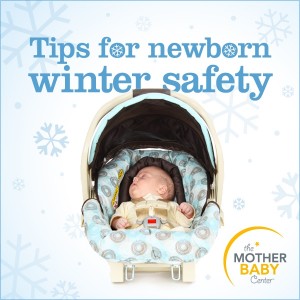 Just because the groundhog saw its shadow doesn’t mean that we will see spring weather anytime soon. According to past weather data, the average low temperature in Minnesota for March and April ranges between 22 and 37 degrees.
Just because the groundhog saw its shadow doesn’t mean that we will see spring weather anytime soon. According to past weather data, the average low temperature in Minnesota for March and April ranges between 22 and 37 degrees.
Becoming a new parent is challenging enough, let alone preparing them for the frigid temperatures outside. Here at The Mother Baby Center, we try our best to prepare you and your new family for what’s outside our doors. Here are some outside and inside winter safety tips to brace your new delivery from the cold:
Outside:
- When taking a newborn out in the cold, use several inner layers, such as a cotton snap-bottom undershirt and a fleece sleeper. Then button your baby up in a polyester or down-filled bunting, and wrap them in a blanket. Placing them in a front carrier inside your coat can help block wind and cold, but make sure their mouth and nose aren’t obstructed. Once inside, be sure to remove layers promptly to avoid overheating; a newborn isn’t any better at cooling their body down.
- A hat is the No. 1 necessity. On very cold days, be sure to use a cap that totally covers the ears, fastens under the chin, is cozy and won’t fall off.
- Thick coats should come off before the car-seat straps go on — the extra padding will make the harness too loose. Add a blanket or a bunting bag (a fitted blanket that goes over a car seat or stroller) over the straps instead.
- Wear your baby against your body in a sling or carrier to keep them warmer when riding in a stroller. This way, you’ll be able to dress your baby in lighter clothing (skip the coat). Keep a blanket on hand to throw over them if they get cold.
- If frostbite occurs, bring the child indoors and place the frostbitten parts of their body in warm (not hot) water. Water at about 104 degrees (the temperature of most hot tubs) is recommended. Warm washcloths may be applied to frostbitten nose, ears and lips.
- Hypothermia develops when a child’s temperature falls below normal due to exposure to colder temperatures. It can occur more quickly in children than in adults. As hypothermia sets in, the child may shiver and become lethargic and clumsy. If you suspect your child is hypothermic, call 911 immediately. Until help arrives, take the child indoors, remove any wet clothing, and wrap him in blankets or warm clothes.
Inside:
- The more comfortably babies are dressed for bed, the better they sleep. If you swaddle your baby, use a lightweight cloth. Cotton’s the best bet for sleeping because it’s cozy, soft and more breathable than other fabrics.
- Skip the blankets in the crib until around 12 months — they’re a suffocation risk before then, and babies just kick them off. Instead, try a coverall (a one-piece outfit with feet, also called a sleeper or a stretchie) or a sleep sack (a wearable blanket with armholes). A fitted flannel crib sheet adds warmth, too.
- Many pediatricians feel that bathing two or three times a week is enough for an infant’s first year. More frequent baths may dry out the skin, especially during the winter.
Resources:
Winterproofing your baby. (2012, December 6).
Sears, M.d., W. (n.d.). Winterproof your baby.
Winter safety tips. (2013, January 17).